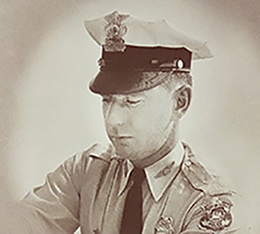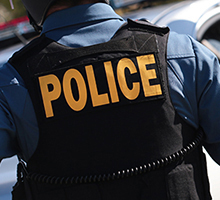
This is an archive of an Office of Justice Programs blog. This page is no longer updated and may contain outdated information and links that no longer function.
Body Armor is Key to Officer Safety
Wednesday, May 16, 2018

When Officer William Krikava of the Tampa, Florida, Police Department saw a woman frantically waving him down in the early hours of New Year's Day 1965, he responded without hesitation.
The woman said that a burglary was taking place in the dress shop she owned. When the officer entered the shop, he found a man and woman stealing clothing. One of the suspects opened fire, striking him in the chest, stomach and legs. The officer returned fire and wounded the shooter but, tragically, Krikava, a married 35-year-old father, died of his injuries.
No one knows if a bulletproof vest would have saved Officer Krikava, had it been available. We do know that his death was part of a troubling trend. During the 1960s, police fatalities were dramatically rising. From 1966 to 1971, the number of officers killed while on duty more than doubled, according to the FBI Uniform Crime Reports. Although people had tried to develop body armor for decades, none of the products proved feasible and effective for law enforcement.
In Washington, DC, the deadly trend spurred the National Institute of Law Enforcement and Criminal Justice, forerunner of the Office of Justice Programs' National Institute of Justice, to launch studies to develop body armor appropriate for on-duty police. Research focused on Kevlar ballistic fabric, a lightweight, exceptionally durable material manufactured by DuPont. Scientists had conceived it as a strengthening agent for car tires. Beginning in 1971, NIJ devoted more than $3 million to developing Kevlar body armor.

NIJ funding also established the Law Enforcement and Standards Laboratory at the agency now known as the National Institute of Standards and Technology. The laboratory published the first performance standard for modern police body armor in 1972. Three years later, NIJ began a one-year field test involving 15 urban police departments that each experienced officer assault rates higher than the national average.
During the field test, the body armor protected officers involved in 18 shootings. A final report issued in 1977 concluded that the new ballistic material was effective.
Some 40 years later, law enforcement officers use body armor extensively. In a 2011 NIJ survey, more than 92 percent of police officers said their agencies required them to wear body armor when on duty "at all times" or "at most times."
Many evidence-based studies reinforce body armor's positive impact on officer safety. In 2017, the National Opinion Research Center, using data from the FBI report on Law Enforcement Officers Killed and Assaulted, published an NIJ-funded study. The study showed that those who wore body armor were 76 percent less likely to be killed than those who did not wear armor.
NIJ continues to develop and test body armor, and its performance standard is the only national one available to law enforcement. NIJ recently released a quick reference guide for law enforcement officers on body armor's selection, care, and maintenance, which are key to its effectiveness.
As of 2018, ballistic-resistant soft body armor has resulted in more than 3,100 officers who have survived potentially fatal or disabling injuries.
Beyond the science, OJP supports officers through the Bullet-Proof Vest Partnership administered by the Bureau of Justice Assistance, which has provided funding to 13,000 jurisdictions to assist in the purchase of more than 1.2 million vests. One of those jurisdictions, Tampa, where officer Krikava's sacrifice has not been forgotten, has received nearly $72,500 since 2000.
Tampa police officer James Wilkinson was shot in the upper torso during a traffic stop in 2006. Ten years later, Tampa police officer Jose Rodriguez was wounded in his chest when he responded to a shooting incident that claimed the lives of two people. Tampa PD says the vests likely saved their lives.
These officers, as well as thousands of others, are alive today because of the body armor developed with the loss of officers like Krikava in mind. In a way, he and other officers who gave their lives in the '60s helped bring about NIJ's life-saving research.
Today, our nation's public safety depends on our law enforcement officers. OJP is proud to continue to ensure that they have body armor, manufactured to meet the highest standards, available to protect them as they protect our communities.

